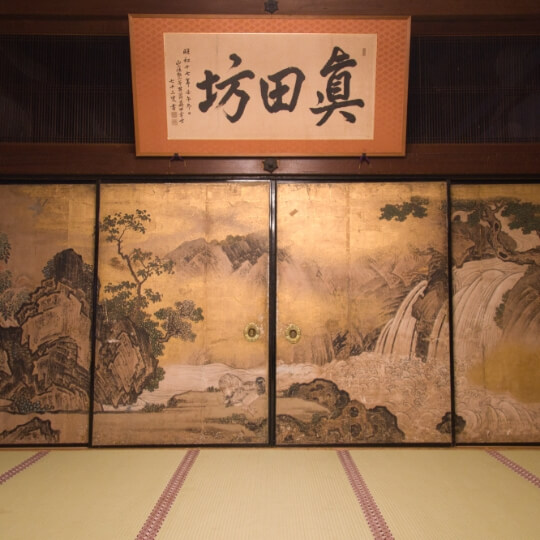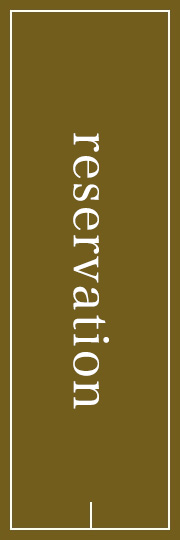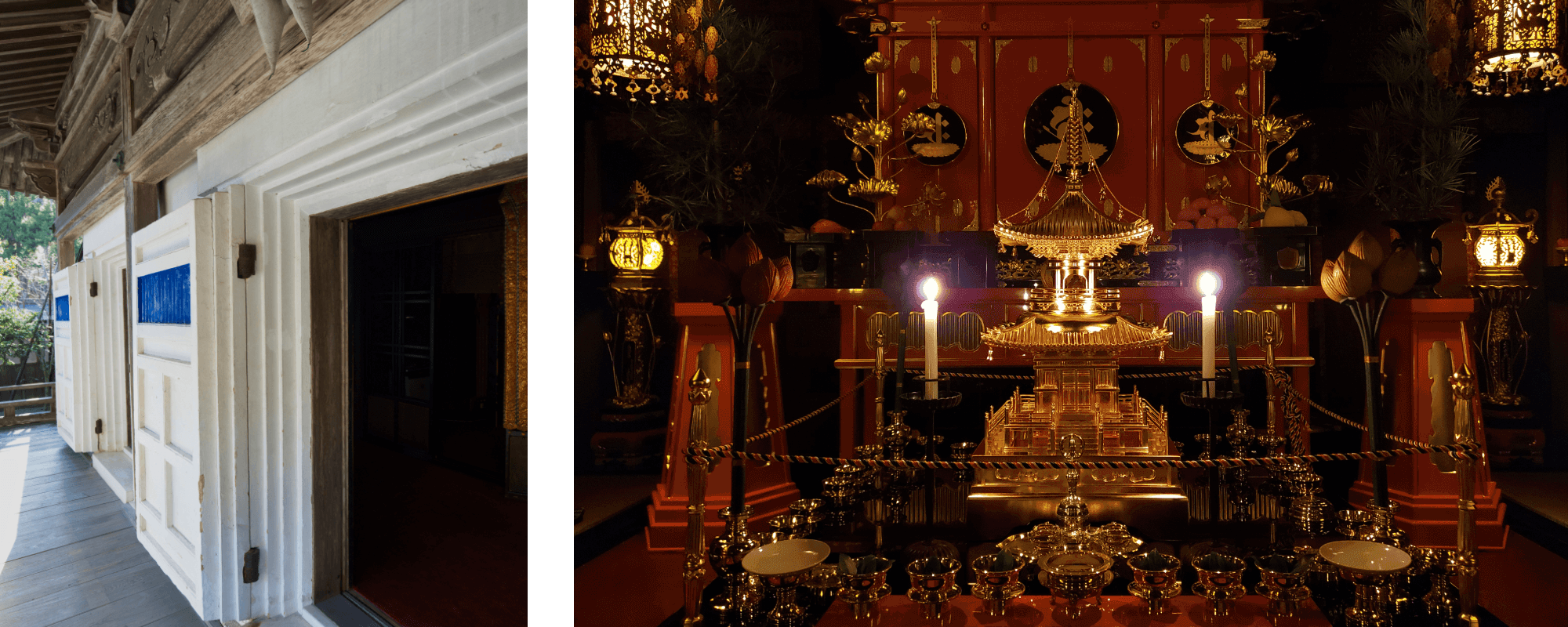
Temple introduction
1.The Main Hall
Following a fire during the Tempo Era (1830-1844), the present main hall (hondo) was reconstructed with the support of the Sanada clan. It has an unusual structure known as roppozo (six-way storehouse), with thick earthen walls on all
sides (the front, back, left, right, top, and bottom).
The miniature shrine in the inner sanctuary houses the principal image of the temple, Amida Nyorai. As a “hidden Buddha,” the image is usually kept hidden from public view with the shrine remaining shut, but one can find the Sanskrit
character hrih on this door as well.
The main hall also contains a mortuary tablet erected by Lord Sanada Masayuki himself before his death.
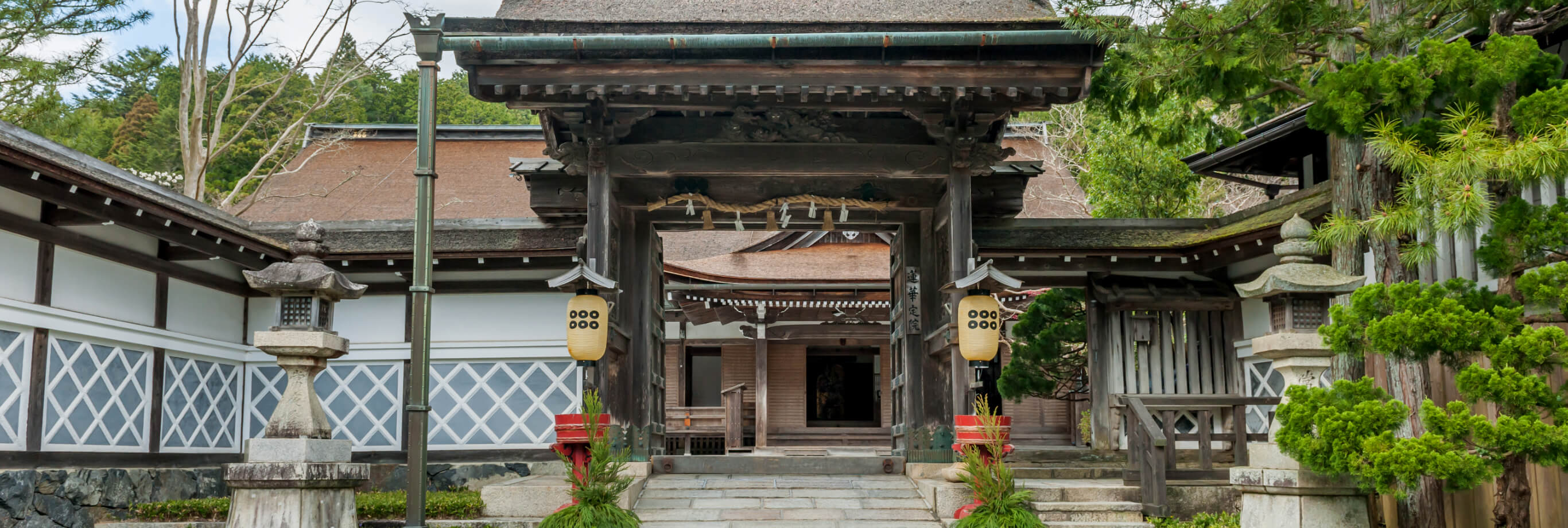
2.The Main Gate
The main gate (sanmon) welcoming visitors is adorned with large paper lanterns raised on poles and bearing the Sanada family crest (the Rokumonsen) and a tablet attesting to the gate’s reconstruction in 1860 with the support of the Sanada clan. Another family crest belonging to the Sanada clan, the Karigane, can be seen on the outer wall.
3.The Front Garden and the Sanskrit Character Hrih
The temple’s front garden is made in the karesansui style that was established in the late Kamakura Period (14th century).Also called “dry gardens” or “rock gardens,” karesansui gardens use stones, sand, plants, and trees to
represent ponds and flowing rivers, expressing the Buddhist view of the world, the universe, and the state of enlightenment.
The pattern drawn in the sand shows the Sanskrit character hrih.
Sanskrit was a language used in ancient India, which made its way to China and then to Japan. It has been said that Kobo Daishi (Kukai) developed the Japanese alphabet based on the Sanskrit script.
The hrih depicted in the sand pattern represents a lotus (renge in Japanese) flower with Amida Nyorai seated in zen meditation on it. When one enters the temple grounds, it points straight to the temple’s principal image of Amida
Nyorai, the hidden Buddha enshrined in the main hall, like a spiritual line connecting the prayerful visitors to Amida Nyorai.
4.The Courtyard
The courtyard is home to a pine tree that is over 500 years old and a maple tree that escaped the flames of the fire that broke out during the Tempo Period and continues to live today.
When you reflect on the fact that Lord Sanada Masayuki and his son Nobushige would have viewed this very garden, you can feel the passage of time from the Warring States Period (1467-1615) and the transitions of nature that are a
unique feature of mountain temples.
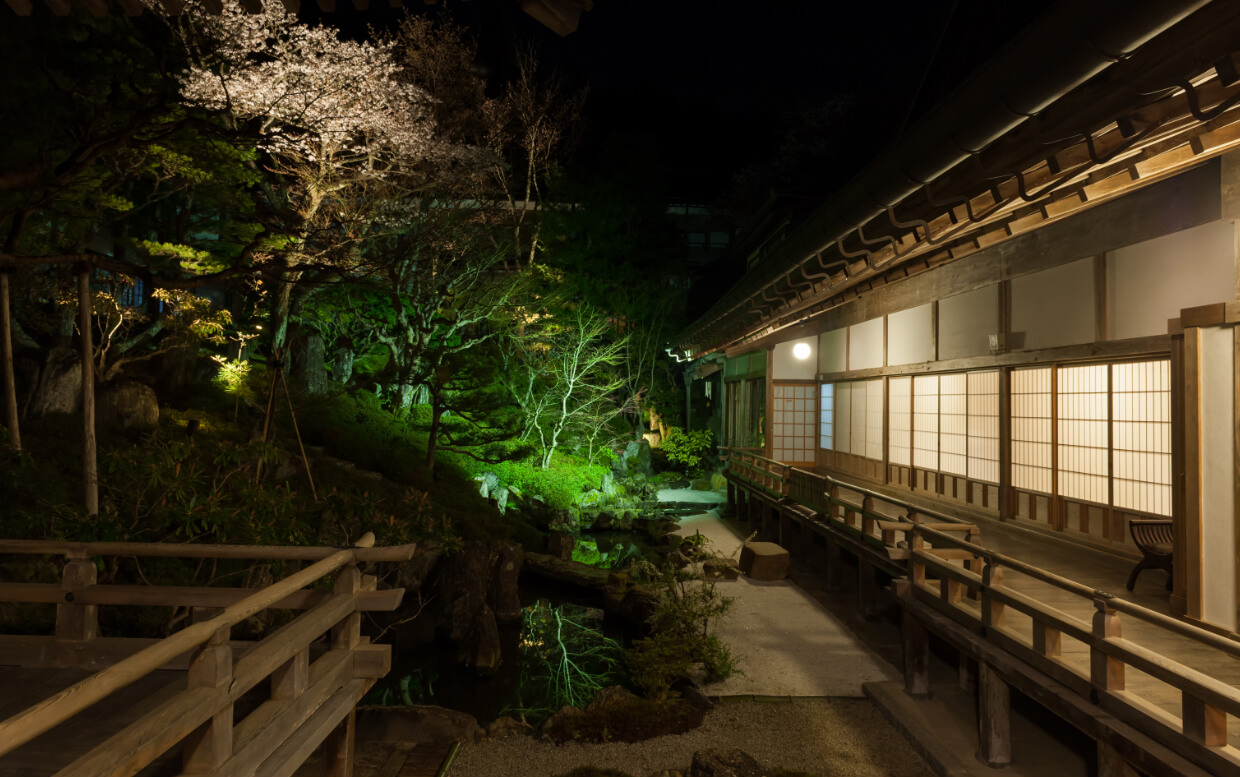
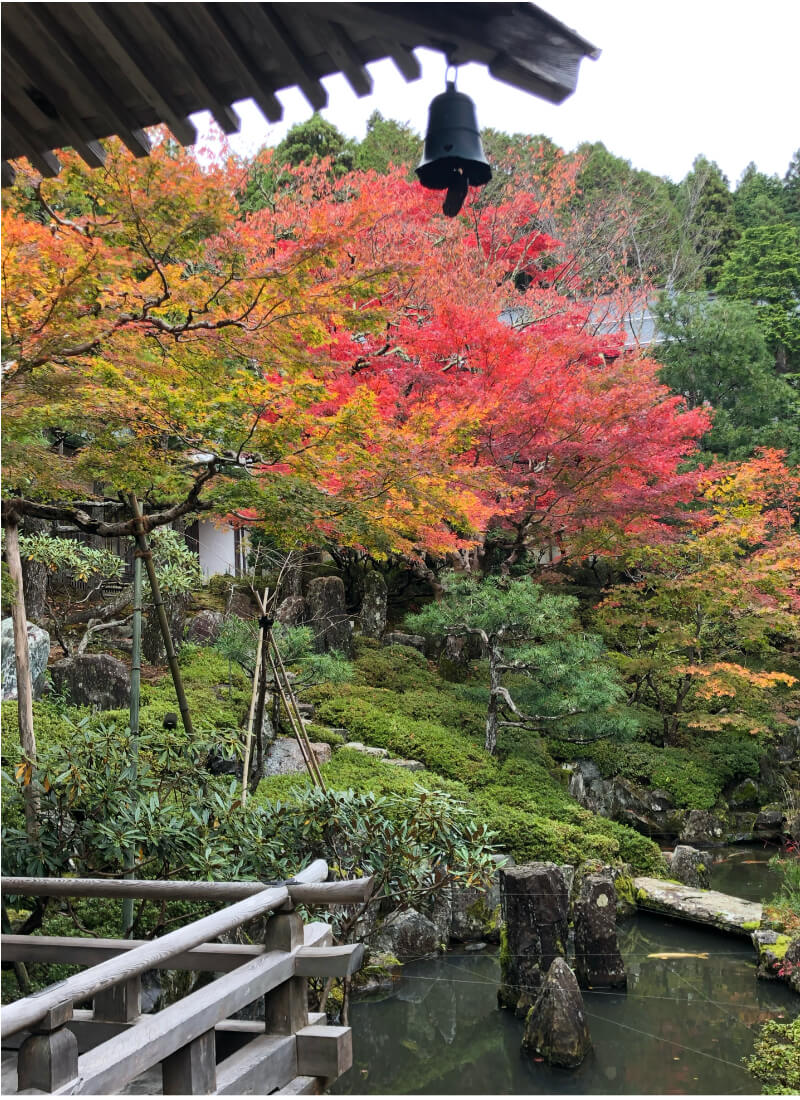
5.Jodan no Ma
A jodan no ma, or lord’s audience chamber, is a room with a raised floor where the lord would sit, elevated above others, when receiving audiences. The kuri (temple kitchen) that housed the jodan no ma where Sanada Masayuki once sat was destroyed by fire during the Edo Period, but it was rebuilt in 1860 in the same place with the same size and in the same style as the original. The reconstruction offers a glimpse into the past.
6.Sanada Family Cemetery
Tombstones were erected at the back of the temple for Nobushige’s older brother Lord Nobuyuki, his son Lord Nobumasa, and the Sanada family. Nobuyuki's name was originally written with the characters 信幸, with the character 幸
(yuki) taken from the name of his father Masayuki (昌幸). After his father opposed Ieyasu, Nobuyuki replaced the 幸 with 之, which is also read yuki. Nevertheless, the tombstone is inscribed with Nobuyuki’s original name of 信幸.
A payment of 1,000 gold ryo was given to the temple for the perpetual performance of Buddhist services for departed members of the Sanada family. A mortuary chapel once stood in front of the tombstones, but it was destroyed by fire
during the Taisho Era (1912-1926).
The chapel once contained mortuary tablets that Nobuyuki’s father Masayuki himself had made during his lifetime. They are now enshrined in the main hall.
7.Gomado
The gomado is a place to pray for sound mind and body and peace in the family by dispelling afflictions with the flames of the goma. A seated statue of the deity Fudo Myo-o is enshrined in this gomado, said to have been inspired in
a dream by a former abbot.
Images of Fudo Myo-o usually have the deity holding a kenzaku (a five-colored rope with a weight on the end) in the left hand and a treasure sword in the right hand, but Rengejo-in's Fudo Myo-o is exceptional in that the right hand
holds a dokkosho (a Buddhist weapon used to crush resentment, expel enemies, and destroy evil).
8.Temple Treasures
- Letter written in Lord Sanada Nobushige’s own hand
Lord Nobushige, who was living in Kudoyama at the time, received an invitation from the abbot of Rengejo-in to attend the grand festival of Niu Myojin, the deity of the landowners of Koyasan. This letter contains his reply, in which he
wrote, “I have a stomachache and can no longer attend. I am sorry.”
The seal at the end of the document, called a kao, shows that Nobushige (Yukimura) himself wrote the letter.
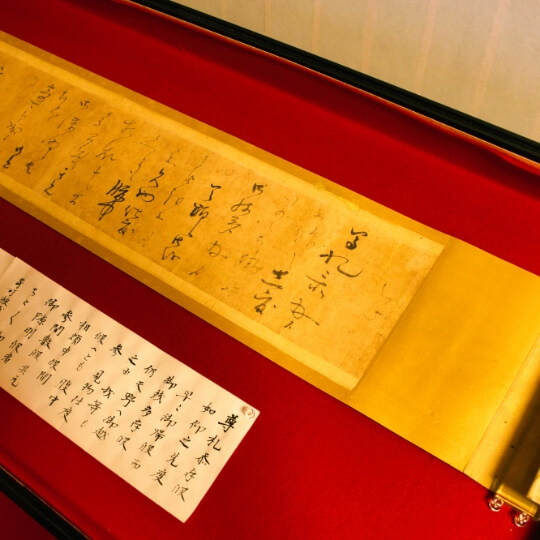
- The Shochu Letter, written in Lord Sanada Nobushige’s own hand
Lord Nobushige is known to have been fond of drink. It seems that while he was confined to Koyasan, he relied on the support of his older brother Nobuyuki, who had become lord of the Matsushiro Domain in Shinshu Province.
His letter to Lord Nobuyuki's vassal Kawahara Sakyo reads, "Fill a pot to the brim with shochu liquor and bring it to me. Seal it tight so nothing spills.”
The kao seal stamped on the letter attests to it also having been written by Nobushige (Yukimura) himself. It is additionally valuable because it bears Nobushige’s priestly name Kohaku, which he received when he was ordained at Koyasan.
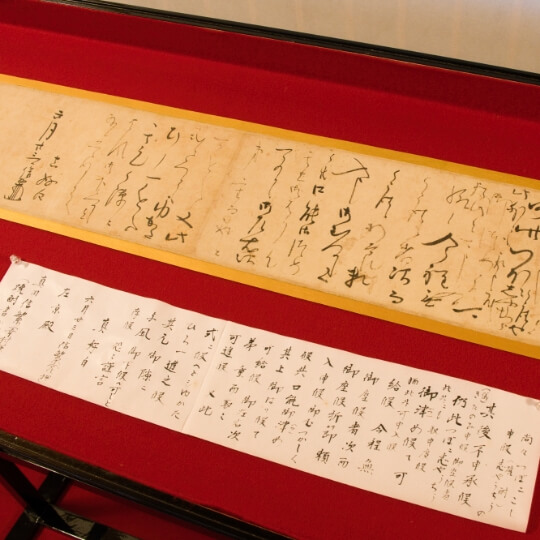
- The Shukubo Agreement Concluded With Lord Sanada Masayuki
At the time, it was not permitted for pilgrims to freely choose a lodge, as they were allocated by region and domain. The reason why many people from the Shinshu region (Chiisagata, Saku, Minochi, Sarashina, and Hanishina counties) stayed at Rengejo-in was because Sanada Masayuki, the feudal lord of Ueda, had concluded a shukubo agreement with the temple. This document is that agreement.
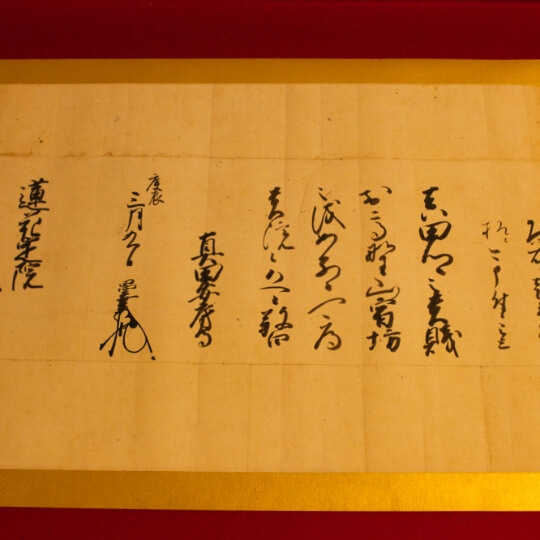
- Namban-Style Helmet (From the Koyasan Reihokan Museum Collection)
The helmet that Nobushige is said to have used in battle still exists. Due to its precious value, it is now kept in the collection of the Koyasan Reihokan Museum.
The Sanada family is famous for its red armor and red helmets. Contrary to popular belief, however, they did not have deer antlers on their helmets, and actually used unadorned armor and helmets. In addition to being too prominent,
antlers would simply get in the way, making them unsuitable for battle.
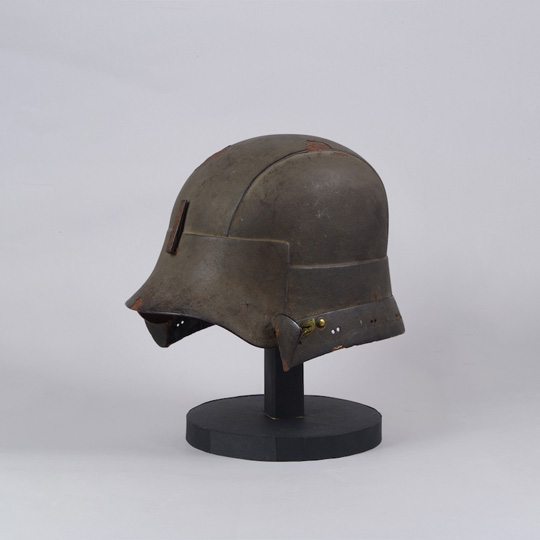
- “Sanadabo” Calligraphy Piece
A framed calligraphy piece reading “Sanadabo” hangs in the reception room. It was presented to the temple in 1942 by the then-head of the Sanada family and is proof of the enduring relationship between Rengejo-in and the Sanada family from the Warring States Period to the present. This work of calligraphy is considered another one of the temple’s precious treasures to be handed down to future generations.
